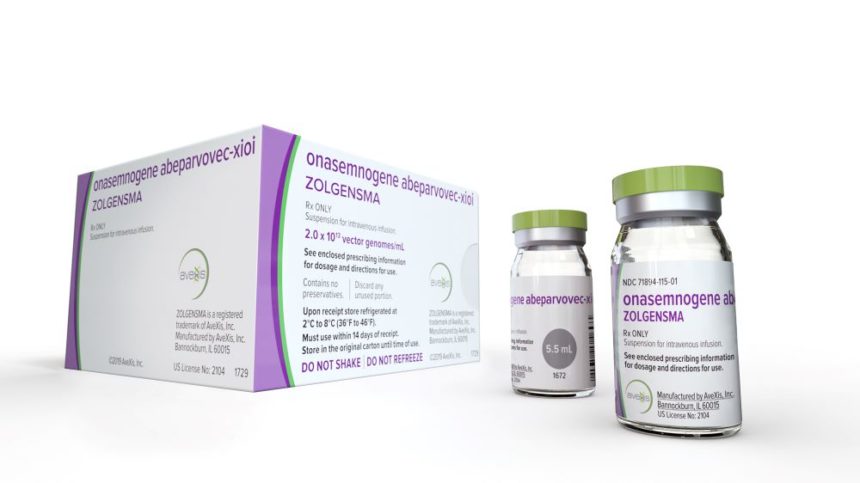The Food and Drug Administration on Friday approved Novartis gene therapy Zolgensma to treat all children less than two with spinal muscular atrophy (SMA), a rare, genetic disease and leading cause of death in infants.
It is being priced at $2.125 million, or an annualized cost of $425,000 per year for five years, Novartis said in a statement, arguing that the price is cost-effective since it’s designed to replace a lifetime of chronic therapy for all pediatric patients with SMA. However, patients will need to be monitored long-term to make sure the effects are durable.
Zolgensma is administered via a single, one-time IV infusion, delivering a functional copy of the gene that regulates production of a protein responsible for certain muscle functions. SMA patients lack a working copy of that gene, called SMN1, and they gradually lose muscle strength, leading to paralysis and death — most often by age two.
The drug has been shown to halt the disease’s progression, although its long-term effects are unknown. “There’s always a chance it could require maintenance,” said Michelle Rivera, PhD, analyst with inThought Research.
The approval comes a week ahead of the expected FDA action date. Now that the agency has made its decision, here’s what could happen.
It’ll trigger a new round of hand-wringing over affordability
- The drug is launching with a variety of affordability options, including pay-over-time options and outcomes-based agreements, both up to five years. The drugmaker said it’s in discussions with more than 15 payers and that some having agreed, in principle, to terms, including Harvard Pilgrim. Still, there will be criticism about affordability and whether the drug is priced responsibly. Amazing-slash-scary stat: 68 gene therapies are forecast to be launched by 2024, per Evaluate.
It’ll spawn a new category of competition
- The incumbent in the SMA market is Biogen’s Spinraza, a biologic that was approved in late 2016 and that costs $750,000 for the first year and $375,000 per year thereafter. Also coming down the pike is an oral, small-molecule drug being developed by Roche and PTC Therapeutics, risdiplam, which the firms hope to submit for FDA approval this year. There are three other SMA drugs in earlier stages of testing.
It’s a test case for curative therapy entering an established market
- When the first U.S.-approved gene therapy, Spark Therapeutics’ Luxturna, got the green light in December 2017 for a rare form of inherited blindness, it had the category more or less to itself. Analysts will be closely tracking to what extent Zolgensma siphons ‘scripts from Spinraza or attracts mainly treatment-naive patients. Novartis will need to convince doctors to go with the pricier gene therapy.
It prompts some new marketing issues…
- The drug was approved to treat all types of SMA (types 1-3), a blessing for communicators, who would otherwise have had to define their materials tightly so as not to be seen as trying to unduly expand the market beyond the first type. Still, there are some weight limitations, and the availability of a corrective therapy will probably generate interest from parents whose children may not fit exactly within the label. “That will become a huge payer concern and a marketing issue of ‘have they effectively and appropriately communicated the population?,’” said Dale Cooke, president, PhillyCooke Consulting. “That will be something [the FDA’s Office of Prescription Drug Promotion] will look at.”
…and some familiar ones
- As with all curative therapies, long-term survival is a big question mark, making it hard to define value. (Zolgensma and Luxturna are presumed to be life-long cures, but no one knows for sure.) Marketers will need to work closely with regulators, payers and ICER to define Zolgensma’s value, using the patient voice and novel endpoints, for example. (In February, ICER said Zolgensma, at a price of $2 million, was more cost-effective than Spinraza, in patients with type 1 SMA, but that the price would need to be lowered in order to meet traditional cost-effectiveness benchmarks.) Speaking of which, payers will ultimately determine Zolgensma’s uptake. But don’t count out the impact of patient advocacy, says Cooke: “If the parents especially are organized and pushing for coverage, then that might limit payers’ leverage.”
Ultimately, no one knows how payers will react
- Zolgensma is launching with some novel payment options, like an outcome-based arrangement offering a rebate if the drug doesn’t perform as promised, and payers seem on-board. However, the uncertainty of its long-term effects could make it hard to pin down terms. “Are there going to be reimbursements three, four or five years down the road based on the failure of the therapy to last?” asked Cooke. “The assumption is it’s a one-time therapy, but especially with patients who have been previously treated or on maintenance, I don’t know what this will look like.”
Novartis, for its part, is counting on the novel therapy as one of two potential blockbuster launches for this year. Jefferies predicted $2.6 billion in global peak sales by 2020, above Wall Street’s consensus estimate of $2 billion.
Zolgensma, previously known as AVXS-101, was developed by the biotech firm AveXis, which Novartis bought last year for $8.7 billion.







